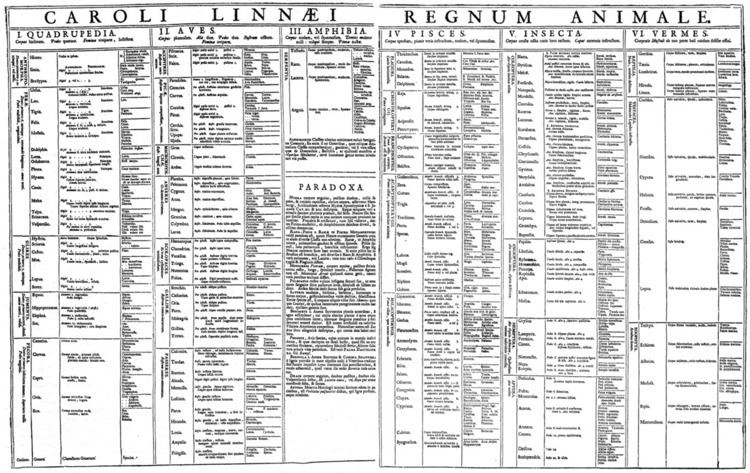Animalia Paradoxa (Latin for "contradictory animals"; cf. paradox) are the mythical, magical or otherwise suspect animals mentioned in editions 1, 2, 3, 4, 5 of Carl Linnaeus's seminal work Systema Naturae under the header "Paradoxa". It lists fantastic creatures found in medieval bestiaries as well as those reported by explorers from abroad and gives explanations to why they are excluded from Systema Naturae. According to Swedish historian Gunnar Broberg, it was to offer a natural explanation and demystify the world of superstition. Paradoxa was dropped from Linnaeus' classification system as of the 6th edition (1748).
These 10 taxa appear in the 1st to 5th editions:
Hydra: Linnaeus wrote: "Hydra: body of a snake, with two feet, seven necks and the same number of heads, lacking wings, preserved in Hamburg, similar to the description of the Hydra of the Apocalypse of St.John chapters 12 and 13. And it is provided by very many as a true species of animal, but falsely. Nature for itself and always the similar, never naturally makes multiple heads on one body. Fraud and artifice, as we ourselves saw [on it] teeth of a weasel, different from teeth of an Amphibian [or reptile], easily detected." See Carl Linnaeus#Doctorate. (Distinguish from the small real coelenterate Hydra (genus).)Rana-Piscis: a South American frog which is significantly smaller than its tadpole stage; it was thus (incorrectly) reported to Linnaeus that the metamorphosis in this species went from 'frog to fish'. In the Paradoxa in the 1st edition of Systema Naturae, Linnaeus wrote "Frog-Fish or Frog Changing into Fish: is much against teaching. Frogs, like all Amphibia, delight in lungs and spiny bones. Spiny fish, instead of lungs, are equipped with gills. Therefore the laws of Nature will be against this change. If indeed a fish is equipped with gills, it will be separate from the Frog and Amphibia. If truly [it has] lungs, it will be a Lizard: for under all the sky it differs from Chondropterygii and Plagiuri.". In the 10th edition of Systema Naturae, Linnaeus named the species Rana paradoxa, though its genus name was changed in 1830 to Pseudis.Monoceros (unicorn): Linnaeus wrote: "Monoceros of the older [generations], body of a horse, feet of a "wild animal", horn straight, long, spirally twisted. It is a figment of painters. The Monodon of Artedi [= narwhal] has the same manner of horn, but the other parts of its body are very different."Pelecanus: Linnaeus wrote "Pelican: The same [sources as for the previous] hand down fabulously [the story] that it inflicts a wound with its beak on its own thigh, to feed its young with the flowing blood. A sack hanging below its throat gave a handle for the story." This source writes: "Linnaeus thought [pelicans] might reflect the over-fervent imaginations of New World explorers"Satyrus: Linnaeus wrote "with a tail, hairy, bearded, with a manlike body, gesticulating much, very fallacious, is a species of monkey, if ever one has been seen."Borometz (aka Scythian Lamb): Linnaeus wrote: "Borometz or Scythian Lamb: is reckoned with plants, and is similar to a lamb; whose stalk coming out of the ground enters an umbilicus; and the same is said to be provided with blood from by chance devouring wild animals. But it is put together artificially from roots of American ferns. But naturally it is an allegorical description of an embryo of a sheep, as has all attributed data.". This source says: "Linnaeus [...] had seen a faked vegetable lamb taken from China to Sweden by a traveler."Phoenix: Linnaeus wrote: "Species of bird, of which only one individual exists in the world, and which when decrepit [arises?] from [its] pyre made of aromatic [plants?] is said fabulously to become again young, to undergo happy former periods of life. In reality it is the date palm, see Kæmpf".Linnaeus wrote: The Bernicla or Scottish goose & Goose-bearing Seashell: is believed by former generations to be born from rotten wood thrown away in the sea. But the Lepas places seaweed on its featherlike internal parts, and somewhat adhering, as if indeed that goose Bernicla was arising from it. Frederick Edward Hulme noted: "[The] barnacle-goose tree was a great article of faith with our ancestors in the Middle Ages."Draco: Linnaeus wrote that it has a "snakelike body, two feet, two wings, like a bat, which is a winged lizard or a ray artificially shaped as a monster and dried." See also Jenny Haniver.Automa Mortis Linnaeus wrote "Death-watch: It produces the sound of a very small clock in walls, is named Pediculus pulsatorius, which perforates wood and lives in it".The above 10 taxa and the 4 taxa following were in the 2nd (1740) edition and the 4th and 5th editions (total 14 entries):
Manticora: Linnaeus wrote merely: "face of a decrepit old man, body of a lion, tail starred with sharp points".Antilope [sic]: Linnaeus wrote merely: "Face of a "wild animal", feet [like those] of cattle, horns like a goat's [but] saw-edged".Lamia: Linnaeus wrote merely: "Face of a man, breasts of a virgin, body of a four-footed animal [but] scaled, forefeet of a "wild animal", hind[feet] [like those] of cattle".Siren: Linnaeus wrote: "Art. gen. 81 Syrene Bartol: As long as it is not seen either living or dead, nor faithfully and perfectly described, it is called in doubt".
